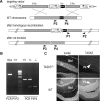Glucose inhibition persists in hypothalamic neurons lacking tandem-pore K+ channels
- PMID: 19244527
- PMCID: PMC6666261
- DOI: 10.1523/JNEUROSCI.5764-08.2009
Glucose inhibition persists in hypothalamic neurons lacking tandem-pore K+ channels
Abstract
Glucose sensing by hypothalamic neurons triggers adaptive metabolic and behavioral responses. In orexin neurons, extracellular glucose activates a leak K(+) current promoting electrical activity inhibition. Sensitivity to external acidification and halothane, and resistance to ruthenium red designated the tandem-pore K(+) (K(2P)) channel subunit TASK3 as part of the glucose-induced channel. Here, we show that glucose inhibition and its pH sensitivity persist in mice lacking TASK3 or TASK1, or both subunits. We also tested the implication of another class of K(2P) channels activated by halothane. In the corresponding TREK1/2/TRAAK triple knock-out mice, glucose inhibition persisted in hypothalamic neurons ruling out a major contribution of these subunits to the glucose-activated K(+) conductance. Finally, block of this glucose-induced hyperpolarizing current by low Ba(2+) concentrations was consistent with the conclusion that K(2P) channels are not required for glucosensing in hypothalamic neurons.
Figures




Similar articles
-
Deletion of TASK1 and TASK3 channels disrupts intrinsic excitability but does not abolish glucose or pH responses of orexin/hypocretin neurons.Eur J Neurosci. 2009 Jul;30(1):57-64. doi: 10.1111/j.1460-9568.2009.06789.x. Epub 2009 Jun 8. Eur J Neurosci. 2009. PMID: 19508695 Free PMC article.
-
Tandem-pore K+ channels mediate inhibition of orexin neurons by glucose.Neuron. 2006 Jun 1;50(5):711-22. doi: 10.1016/j.neuron.2006.04.032. Neuron. 2006. PMID: 16731510
-
Contribution of TWIK-related acid-sensitive K+ channel 1 (TASK1) and TASK3 channels to the control of activity modes in thalamocortical neurons.J Neurosci. 2003 Jul 23;23(16):6460-9. doi: 10.1523/JNEUROSCI.23-16-06460.2003. J Neurosci. 2003. PMID: 12878686 Free PMC article.
-
Orexin neurons and the TASK of glucosensing.Neuron. 2006 Jun 1;50(5):665-7. doi: 10.1016/j.neuron.2006.05.014. Neuron. 2006. PMID: 16731504 Review.
-
K+ channels stimulated by glucose: a new energy-sensing pathway.Pflugers Arch. 2007 Apr;454(1):19-27. doi: 10.1007/s00424-006-0189-8. Epub 2007 Jan 6. Pflugers Arch. 2007. PMID: 17206449 Review.
Cited by
-
Altered detrusor contractility and voiding patterns in mice lacking the mechanosensitive TREK-1 channel.BMC Urol. 2019 May 21;19(1):40. doi: 10.1186/s12894-019-0475-3. BMC Urol. 2019. PMID: 31113422 Free PMC article.
-
Mouse models of adrenocortical tumors.Mol Cell Endocrinol. 2016 Feb 5;421:82-97. doi: 10.1016/j.mce.2015.11.031. Epub 2015 Dec 8. Mol Cell Endocrinol. 2016. PMID: 26678830 Free PMC article. Review.
-
Predictive models of glucose control: roles for glucose-sensing neurones.Acta Physiol (Oxf). 2015 Jan;213(1):7-18. doi: 10.1111/apha.12360. Epub 2014 Aug 28. Acta Physiol (Oxf). 2015. PMID: 25131833 Free PMC article. Review.
-
In vivo evaluation of radiotracers targeting the melanin-concentrating hormone receptor 1: [11C]SNAP-7941 and [18F]FE@SNAP reveal specific uptake in the ventricular system.Sci Rep. 2017 Aug 14;7(1):8054. doi: 10.1038/s41598-017-08684-6. Sci Rep. 2017. PMID: 28808288 Free PMC article.
-
Motoneuronal TASK channels contribute to immobilizing effects of inhalational general anesthetics.J Neurosci. 2010 Jun 2;30(22):7691-704. doi: 10.1523/JNEUROSCI.1655-10.2010. J Neurosci. 2010. PMID: 20519544 Free PMC article.
References
-
- Aller MI, Wisden W. Changes in expression of some two-pore domain potassium channel genes (KCNK) in selected brain regions of developing mice. Neuroscience. 2008;151:1154–1172. - PubMed
-
- Burdakov D, Jensen LT, Alexopoulos H, Williams RH, Fearon IM, O'Kelly I, Gerasimenko O, Fugger L, Verkhratsky A. Tandem-pore K+ channels mediate inhibition of orexin neurons by glucose. Neuron. 2006;50:711–722. - PubMed
-
- Chemelli RM, Willie JT, Sinton CM, Elmquist JK, Scammell T, Lee C, Richardson JA, Williams SC, Xiong Y, Kisanuki Y, Fitch TE, Nakazato M, Hammer RE, Saper CB, Yanagisawa M. Narcolepsy in orexin knockout mice: molecular genetics of sleep regulation. Cell. 1999;98:437–451. - PubMed
Publication types
MeSH terms
Substances
LinkOut - more resources
Full Text Sources
Other Literature Sources
Molecular Biology Databases
